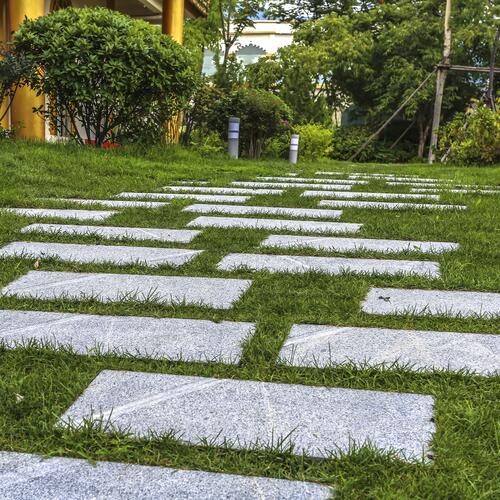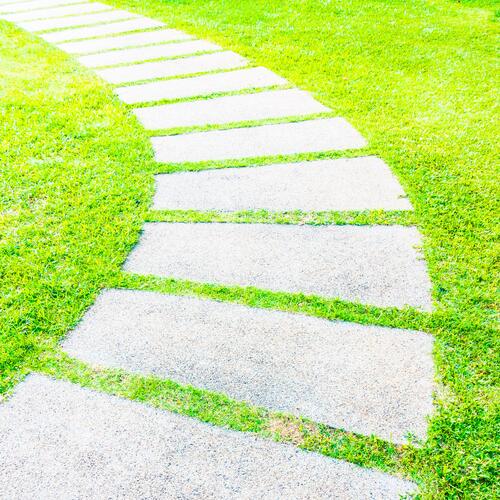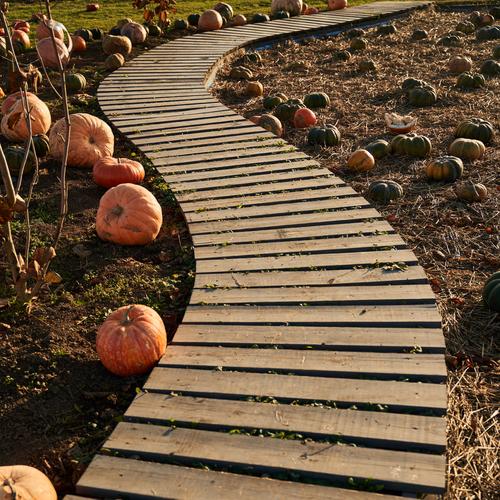Designing A Garden Pathway
Designing A Garden Pathway
A garden pathway is a designated route or walkway within a garden or outdoor space that provides a passage for foot traffic. It serves both functional and aesthetic purposes, guiding visitors through the garden while also enhancing the overall design and layout of the landscape. Garden pathways can be made from various materials such as gravel, concrete, paving stones, wood, or porcelain slabs, and they can range in width and style depending on the preferences and needs of the gardener. These pathways can lead to different areas of the garden, including seating areas, focal points, or points of interest, creating a cohesive and organized flow throughout the outdoor space.

Ways to Create a Garden Pathway
Gravel Paths: Gravel paths are a classic and versatile option for garden pathways. They are easy to install, relatively low-cost, and allow for good drainage. You can choose from various types and sizes of gravel to match your garden's style and theme.
Stepping Stones: Stepping stone pathways add a whimsical touch to your garden while providing a functional route for walking. You can use natural stones, concrete pavers, or even recycled materials like old bricks or tiles to create stepping-stone paths.
Flagstone Pathways: Flagstone pathways offer a rustic and natural look that complements gardens with a cottage or country-style aesthetic. These flat, irregularly shaped stones can be laid out in various patterns to create unique and visually appealing pathways.
Wooden Walkways: Wooden walkways add warmth and character to your garden while providing a comfortable surface for walking. You can use wooden planks, decking boards, or even reclaimed railway sleepers to create raised or ground-level pathways.
Pebble Mosaic Paths: Pebble mosaic paths are a creative way to add intricate designs and patterns to your garden pathways. Using different coloured pebbles or stones, you can create beautiful mosaic designs that become focal points in your garden.
Grass or Turf Paths: Grass or turf paths blend seamlessly with the surrounding landscape, creating a natural and eco-friendly pathway option. You can create grass paths by leaving strips of lawns between planted areas or using special turf reinforcement products for heavy foot traffic areas.
Concrete or Paver Paths: Concrete or paver pathways offer durability and versatility, with various shapes, sizes, and colours to choose from. You can create straight, curved, or meandering paths using concrete slabs, bricks, or interlocking pavers.
Mulch or Bark Paths: Mulch or bark paths are an affordable and low-maintenance option for garden pathways. Simply lay down a layer of mulch or bark chips to create a soft and natural-looking path that blends into your garden landscape.
Shell or Seashell Paths: Shell or seashell paths add a coastal-inspired touch to your garden and are especially suitable for beach-themed or seaside gardens. Crushed shells or whole shells can be used to create unique and decorative pathways.
Mixed Material Paths: For a truly eclectic and personalized look, consider combining different materials to create mixed material pathways. You can mix and match gravel with stepping stones, pavers with turf, or any combination that suits your garden style.
By exploring these different options and getting creative with your designs, you can create beautiful and functional garden pathways that enhance the overall look and feel of your outdoor space.

Pros & Cons of a Garden Pathway
Having a garden pathway offers several benefits, but there are also some potential drawbacks to consider. Here's a breakdown of the pros and cons of having a garden pathway:
Pros:
Enhanced Aesthetics: A garden pathway can enhance the overall appearance of your outdoor space, adding visual interest and structure to your garden design. It can create a focal point and lead the eye through the landscape, making your garden more visually appealing.
Improved Accessibility: Pathways provide a designated route for walking through your garden, making it easier to navigate and enjoy different areas of your outdoor space. They can improve accessibility for people of all ages and abilities, including those with mobility issues.
Functional Use: Garden pathways serve a practical purpose by providing a clear and defined walking surface. They help prevent the trampling of plants and flowers and protect your lawn from damage caused by foot traffic.
Safety: Pathways can improve safety in your garden by reducing the risk of slips, trips, and falls. They provide a stable and secure surface for walking, especially in wet or muddy conditions.
Erosion Control: Well-designed pathways can help control soil erosion by directing foot traffic along designated routes. This can prevent soil compaction and runoff, preserving the health of your garden beds and landscaping.
Cons:
Installation Costs: Building a garden pathway can be expensive, especially if you opt for materials like paving stones or concrete. The cost of materials and labor can add up quickly, depending on the size and complexity of the pathway.
Maintenance Requirements: Pathways require regular maintenance to keep them clean, safe, and attractive. Depending on the material used, you may need to sweep, weed or pressure wash the pathway periodically to prevent debris buildup and maintain its appearance.
Limited Flexibility: Once installed, garden pathways are relatively permanent structures that are challenging to modify or relocate. If you decide to change your garden layout or design in the future, you may need to remove or replace the pathway, which can be time-consuming and costly.
Weed Growth: Depending on the type of pathway material used, weeds and grass may grow between cracks or joints over time, requiring regular maintenance to keep the pathway clear and weed-free.
Environmental Impact: Some pathway materials, such as concrete or asphalt, can have environmental drawbacks, such as heat absorption and runoff. Choosing permeable materials or incorporating green pathways can help mitigate these impacts.
Overall, while garden pathways offer numerous benefits in terms of aesthetics, functionality, and safety, it's essential to weigh the potential drawbacks and consider your specific needs and preferences before installing a pathway in your garden.

Maintaining a Garden Pathway
Regular Cleaning: Sweep the pathway regularly to remove debris such as leaves, dirt, and twigs. Use a broom or a leaf blower to keep the surface clean and prevent buildup that can make the pathway slippery.
Regular Cleaning: Sweep the pathway regularly to remove debris such as leaves, dirt, and twigs. Use a broom or a leaf blower to keep the surface clean and prevent buildup that can make the pathway slippery.
Spot Cleaning: Address any spills or stains on the porcelain slabs promptly to prevent them from becoming permanent. Use a mild detergent or soap mixed with water to spot-clean the affected areas. Scrub gently with a soft-bristle brush or sponge, then rinse thoroughly with water.
Avoid Harsh Chemicals: Refrain from using harsh chemicals, bleach, or abrasive cleaners on porcelain slabs, as they can damage the surface or cause discolouration. Stick to gentle, non-abrasive cleaning solutions to preserve the integrity of the porcelain.
Pressure Washing: Periodically pressure wash the pathway to remove stubborn dirt, grime, or algae buildup. Use a pressure washer with a low-pressure nozzle and warm, soapy water to clean the surface thoroughly. Avoid using excessive pressure, as it can damage the porcelain slabs.
Weed Control: Keep an eye out for weeds growing between the joints or cracks of the porcelain slabs. Remove any weeds by hand or use a weed killer specifically formulated for use on paved surfaces. Regularly inspect the pathway for signs of weed growth and address them promptly to prevent them from spreading.
Sealing (Optional): While porcelain slabs are naturally resistant to stains and moisture, you may choose to apply a penetrating sealer to enhance their protection and longevity. Consult with a professional to determine if sealing is necessary for your specific pathway and follow the manufacturer's recommendations for application.
Repair Damaged Slabs: If any porcelain slabs become cracked, chipped, or damaged, replace them promptly to maintain the integrity and safety of the pathway. Contact a professional installer or supplier to obtain replacement slabs that match the existing ones in colour and texture.
By following these maintenance tips, you can keep your porcelain slab garden pathway looking clean, beautiful, and inviting for years to come. Regular upkeep will help preserve the appearance and functionality of the pathway while minimizing the need for costly repairs or replacements.

